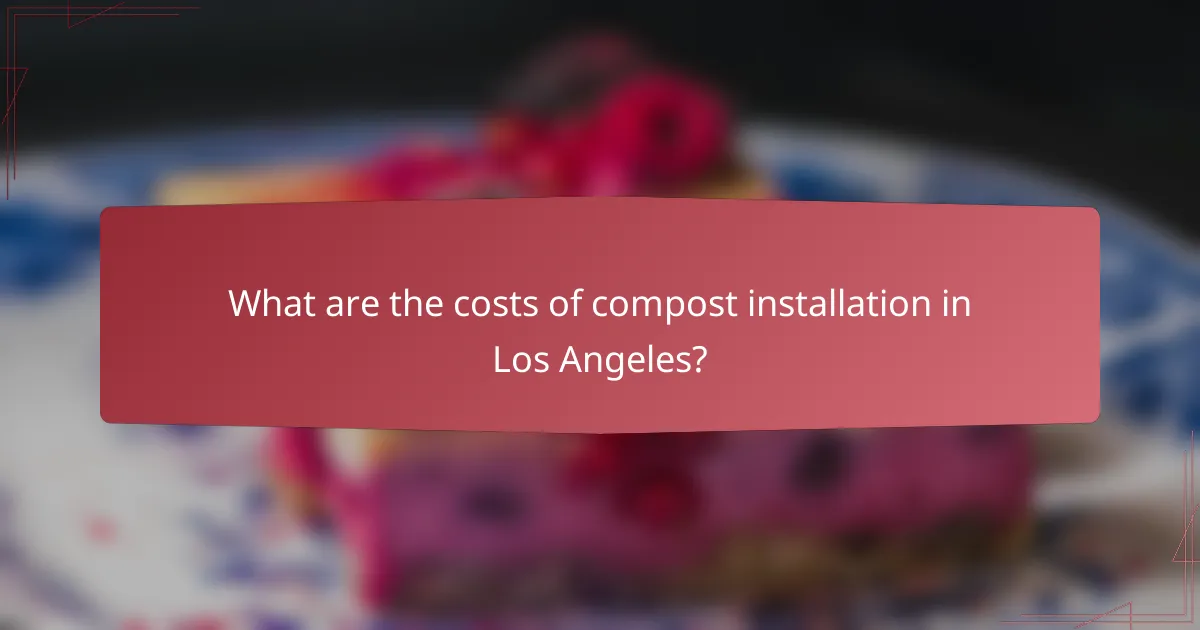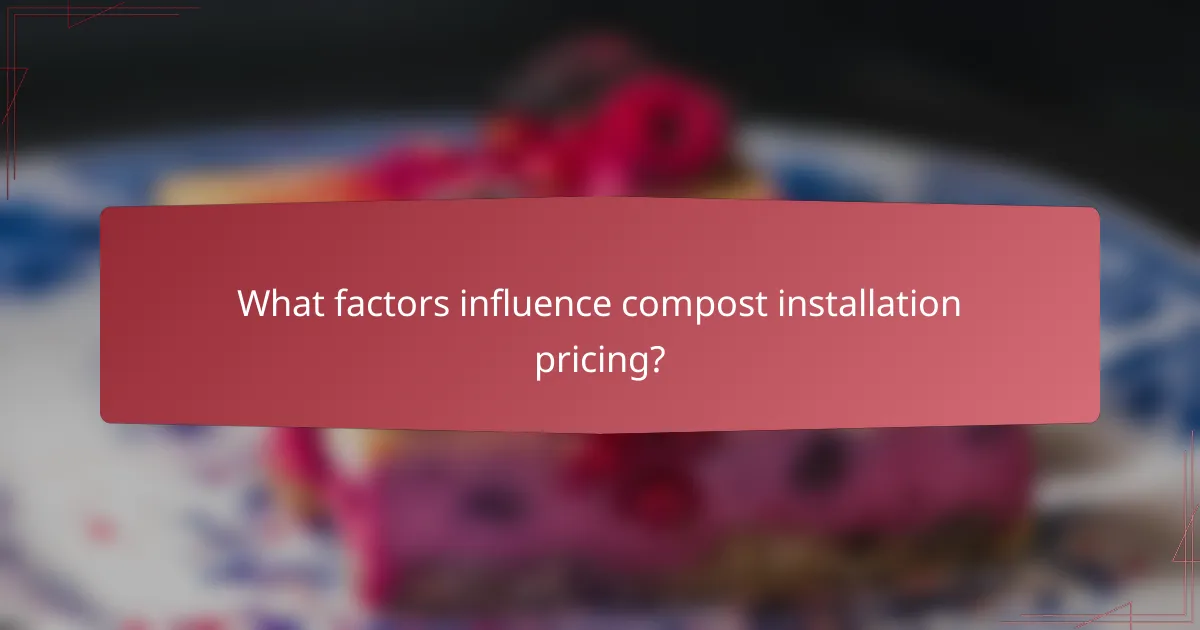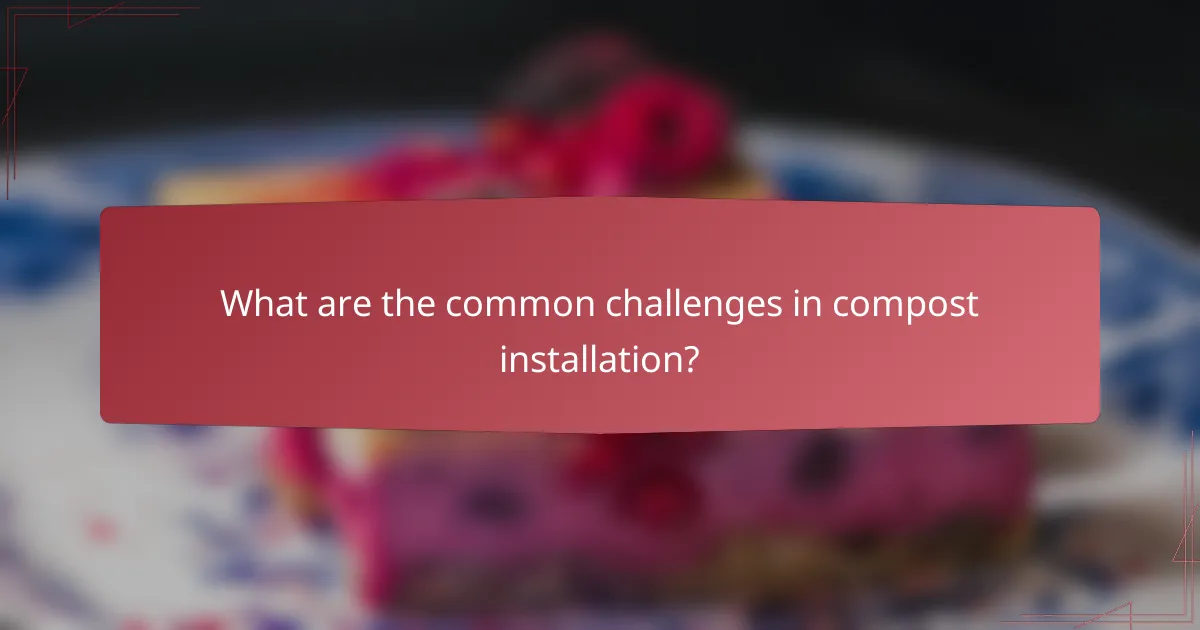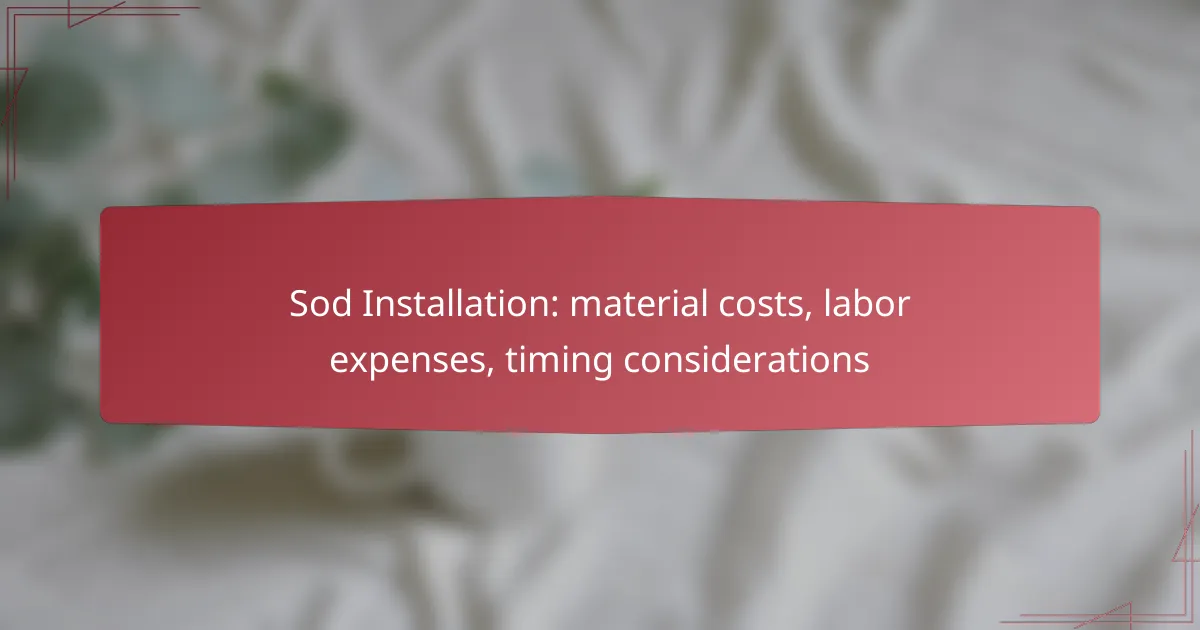Compost installation in Los Angeles involves various costs related to materials, labor, and ongoing maintenance, making it essential for homeowners to understand their investment. Factors such as the type of compost system, installation area size, and soil condition significantly influence pricing. By considering these elements, homeowners can make informed decisions and ensure effective composting practices.

What are the costs of compost installation in Los Angeles?
The costs of compost installation in Los Angeles can vary significantly based on materials, labor, and ongoing maintenance. Homeowners should expect to invest in both initial setup and periodic upkeep to ensure effective composting.
Material costs breakdown
Material costs for compost installation typically range from low hundreds to over a thousand dollars, depending on the size and type of compost system chosen. Basic compost bins can be purchased for around $50 to $200, while larger, more durable systems may cost between $300 and $600.
Additionally, organic materials such as kitchen scraps, yard waste, and carbon-rich materials like straw or shredded paper may incur minimal costs if sourced from home. However, purchasing bulk materials can add $100 to $300 to the overall expense.
Labor costs overview
Labor costs for compost installation in Los Angeles may vary depending on whether you choose to do it yourself or hire professionals. DIY efforts can save money, but hiring a landscaper or gardening service typically costs between $50 and $100 per hour.
For a complete installation, expect to pay for 2 to 4 hours of labor, leading to a total labor cost of $100 to $400. This investment can ensure proper setup and adherence to local regulations.
Average total installation cost
The average total installation cost for composting systems in Los Angeles generally falls between $300 and $1,000. This range includes materials and labor, providing a comprehensive view of what to expect financially.
When budgeting, consider ongoing maintenance costs, which may include purchasing additional materials or hiring help for upkeep. Setting aside an annual budget of $50 to $200 for maintenance can help keep your compost system functioning optimally.

What factors influence compost installation pricing?
The pricing for compost installation is influenced by several key factors, including the type of compost system chosen, the size of the installation area, and the condition of the soil that requires preparation. Understanding these elements can help in estimating costs and making informed decisions.
Type of compost system
The type of compost system significantly affects installation costs. Common options include traditional compost bins, tumblers, and in-ground systems, each with varying price points. For instance, a simple bin may cost less than $100, while a more complex tumbler or in-ground system can range from $200 to $1,000 or more, depending on materials and design.
When selecting a system, consider factors such as ease of use, maintenance requirements, and the volume of compost needed. More sophisticated systems may offer faster composting but can incur higher initial costs.
Size of the installation area
The size of the installation area directly correlates with the overall cost of compost installation. Larger areas require more materials and labor, leading to increased expenses. For example, a small backyard compost setup may cost a few hundred dollars, while larger community composting projects can run into thousands.
To manage costs, assess the space available and determine the optimal size for your composting needs. A compact system may suffice for a small household, while larger setups may be necessary for gardens or community initiatives.
Soil condition and preparation
The condition of the soil where the compost will be installed plays a crucial role in pricing. Poor soil may require additional preparation, such as tilling or amending, which can add to labor and material costs. If the soil is compacted or lacks organic matter, expect to invest more in preparation.
Before installation, evaluate the soil’s condition and plan for any necessary amendments. This proactive approach can help avoid unexpected costs and ensure a successful composting process. Regular soil testing can also provide insights into what preparations are needed, allowing for better budgeting.

How to choose a compost installation service in Los Angeles?
Choosing a compost installation service in Los Angeles involves evaluating qualifications, customer feedback, and service coverage. Focus on providers with relevant experience, positive reviews, and a commitment to serving your specific area.
Service provider qualifications
When selecting a compost installation service, verify their qualifications, including certifications in sustainable practices and experience in compost systems. Look for companies that are knowledgeable about local regulations regarding composting and waste management.
Consider asking potential providers about their training and the types of compost systems they specialize in, such as in-vessel composting or traditional pile systems. This ensures they can meet your specific composting needs effectively.
Customer reviews and testimonials
Customer reviews and testimonials can provide valuable insights into the reliability and quality of a compost installation service. Check online platforms like Yelp or Google Reviews for feedback from previous clients.
Look for consistent themes in the reviews, such as punctuality, professionalism, and the effectiveness of the compost systems installed. A service with a high number of positive reviews is often a safer choice.
Service area coverage
Ensure that the compost installation service covers your specific area in Los Angeles. Some companies may only serve certain neighborhoods or regions, which can affect availability and response times.
Ask about any additional fees for travel outside their primary service area. Understanding these details upfront can help you avoid unexpected costs and ensure timely service for your compost installation project.

What is the ongoing upkeep for compost systems?
The ongoing upkeep for compost systems involves regular maintenance to ensure efficient decomposition and prevent issues such as odor or pests. This includes tasks like turning the compost, monitoring moisture levels, and adding materials as needed.
Maintenance frequency
Compost systems typically require maintenance every few weeks, depending on the size of the system and the materials being composted. For active composting, turning the pile every 1-2 weeks helps aerate it and speeds up decomposition. In contrast, passive systems may need less frequent attention, possibly every month or two.
Common upkeep tasks
Key upkeep tasks for compost systems include turning the compost pile, checking moisture levels, and adding new organic materials. Turning the pile helps aerate it, while maintaining moisture ensures proper microbial activity. Additionally, monitoring the balance of greens (nitrogen-rich materials) and browns (carbon-rich materials) is crucial for effective composting.
Cost of ongoing maintenance
The cost of ongoing maintenance for compost systems can vary widely based on the size of the system and the materials used. Generally, homeowners can expect to spend a modest amount on additional organic materials, such as kitchen scraps or yard waste, which may be free or low-cost. If professional services are needed, costs could range from a few dozen to a couple of hundred dollars annually, depending on the service frequency and local rates.

What are the benefits of composting?
Composting offers numerous benefits, including reducing waste, enriching soil, and promoting environmental sustainability. By transforming organic materials into nutrient-rich compost, individuals and communities can enhance their gardening efforts while minimizing landfill contributions.
Environmental impact
Composting significantly reduces the amount of organic waste sent to landfills, which in turn decreases methane emissions—a potent greenhouse gas. By recycling food scraps and yard waste, composting helps lower the carbon footprint associated with waste disposal.
Moreover, composting contributes to biodiversity by supporting healthy ecosystems. The nutrients released during the composting process can enhance soil quality, leading to better plant growth and a more vibrant environment.
Soil health improvement
Compost improves soil structure, moisture retention, and nutrient availability, which are essential for healthy plant growth. It enriches the soil with beneficial microorganisms that promote plant health and resilience against pests and diseases.
Incorporating compost into garden beds can lead to increased yields and improved crop quality. A general guideline is to mix compost into the top few inches of soil at a ratio of about one part compost to three parts soil.
Cost savings on waste disposal
By composting, households can reduce their waste disposal costs, as many municipalities charge fees based on the volume of waste collected. Composting can lead to a significant decrease in the amount of waste needing collection, potentially saving families tens to hundreds of dollars annually.
Additionally, using compost in place of commercial fertilizers can further cut costs. Compost provides essential nutrients at a fraction of the price of store-bought fertilizers, making it a cost-effective choice for gardeners and farmers alike.

What are the common challenges in compost installation?
Compost installation can present several challenges, including pest management, maintaining proper moisture levels, and ensuring adequate aeration. Addressing these issues early can lead to a more successful composting process.
Pest management
Pest management is crucial in compost installation, as compost piles can attract rodents, insects, and other unwanted animals. To minimize pest issues, consider using a closed compost bin instead of an open pile, which can deter many pests.
Regularly turning the compost helps aerate it and can disrupt pest habitats. Additionally, incorporating materials like citrus peels or coffee grounds can act as natural repellents against certain insects.
Be cautious about adding meat, dairy, or oily foods to your compost, as these can attract pests. Instead, focus on plant-based scraps and yard waste to create a balanced compost that is less appealing to unwanted visitors.



